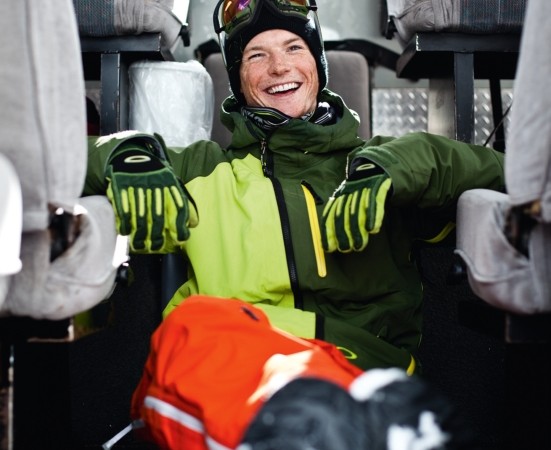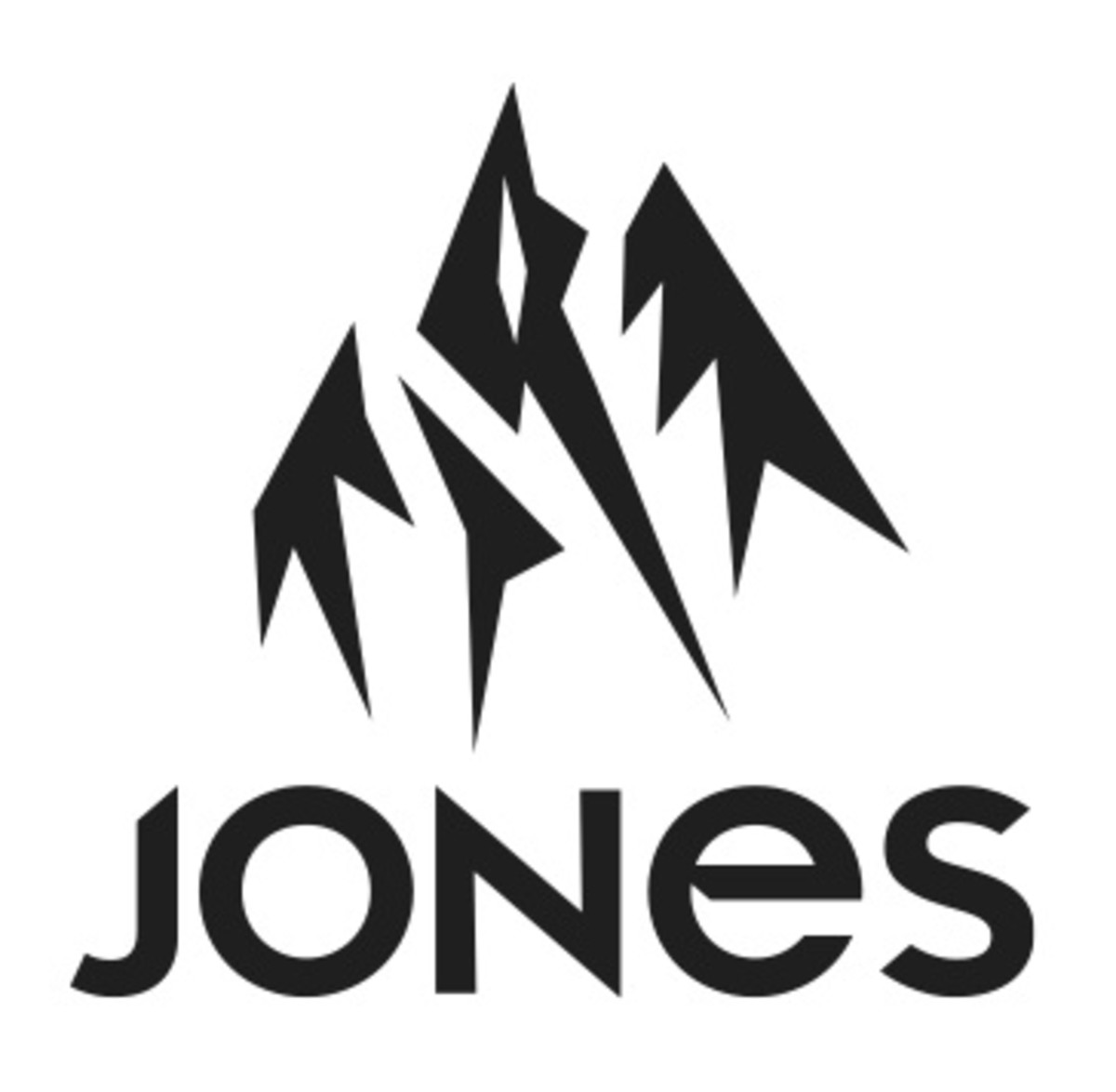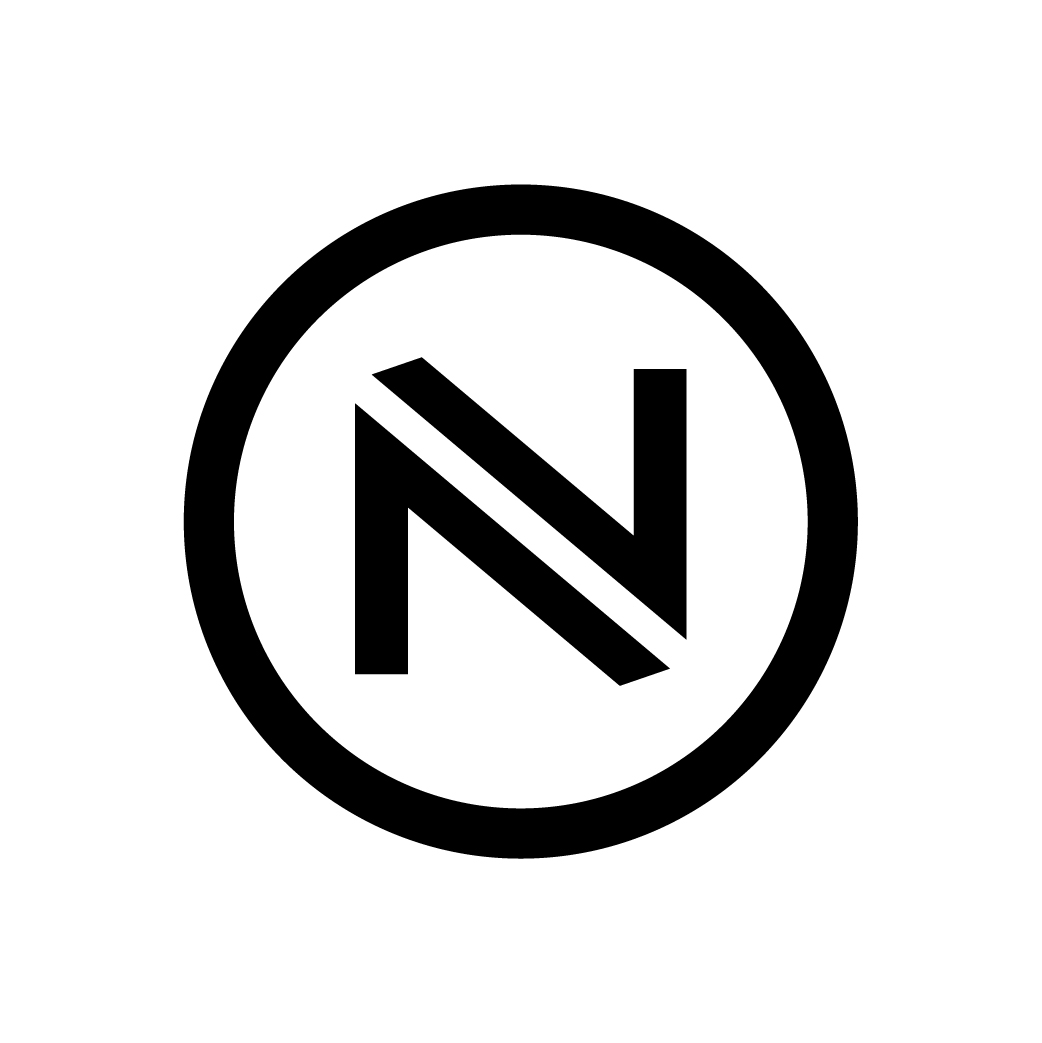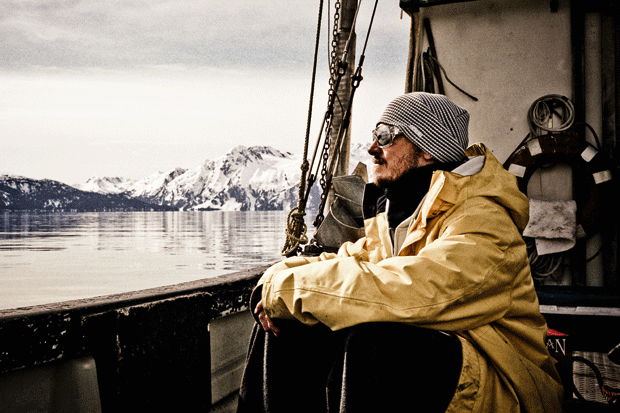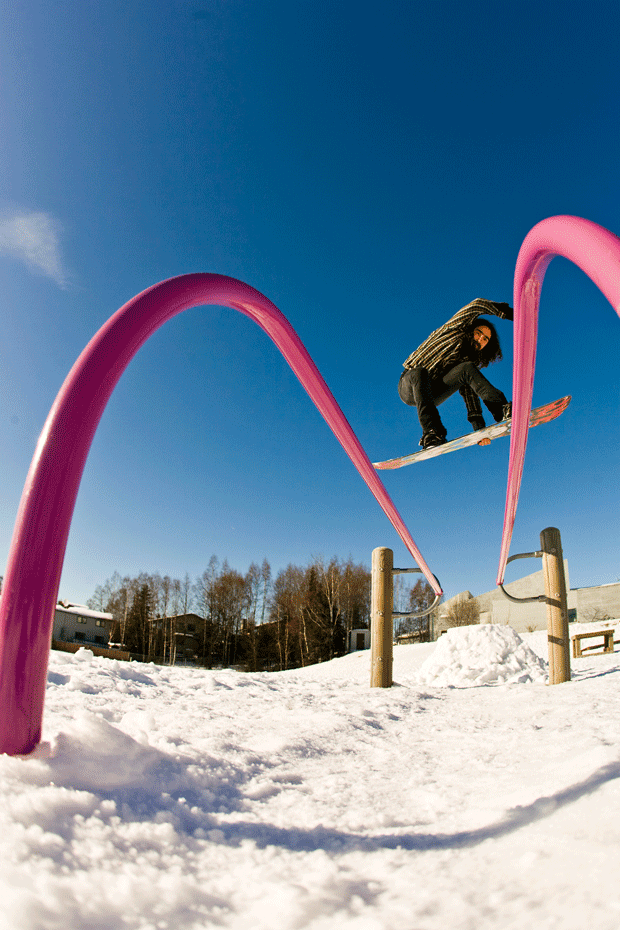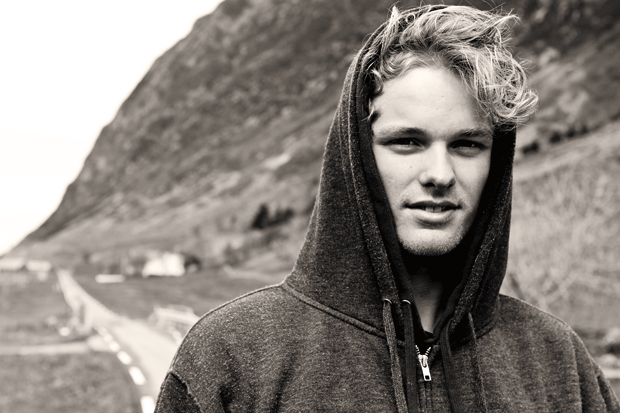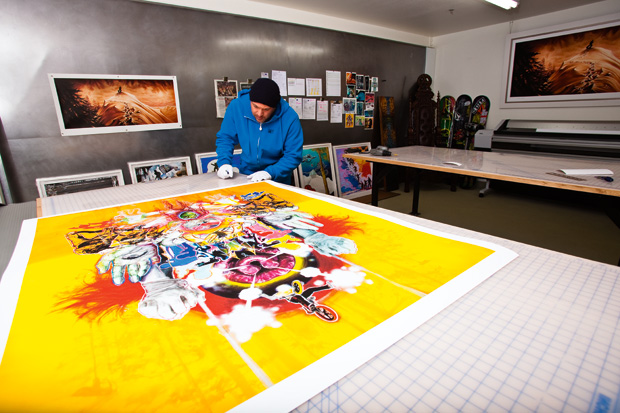Taken from Whitelines Issue 91 October 2010
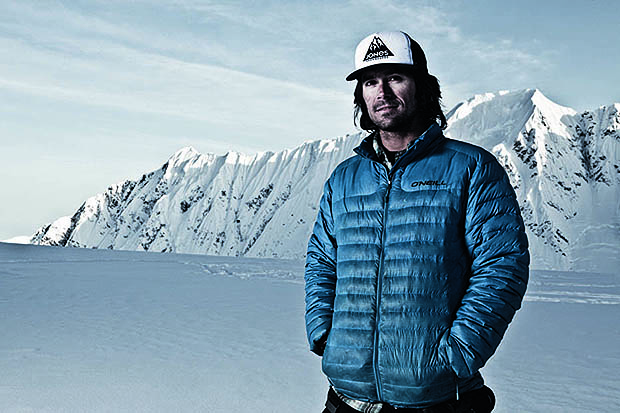
You get this endorphin buzz on the way up – what’s called the runner’s high – and then you get the adrenaline on the way down, and the cocktail of chemicals, man… it leaves you screaming like a little kid.
The opening segment of 91 Words for Snow is classic Jeremy Jones. Transported via a helmet cam to a remote Alaskan ridgeline, we creep carefully along the edge of a cornice. Jeremy’s radio crackles with observations from a nearby camera team; the snowpack squeaks underfoot. There’s a brief exchange with his eye in the sky, then a digital point-and-shoot emerges and Jeremy checks his line on the LCD. As the camera jerks down to the ground and he calmly straps in, a helicopter rumbles past. The roar of its rotor blades is soon drowned out by the wind as, with little fanfare, we drop over the abyss and gather speed down a sheer, powdery face. Sluff barrels past. The mic picks up muffled whoops of joy… Fade to white…
Since freeriding’s glory days of the 1990s, when big lines featured in every ‘TB’ movie and Alaska’s ‘King of the Hill’ comp was going strong, pure powder riding like this has been something of a sideshow. In recent years, the industry has instead focused on promoting young freestyle riders and park-oriented equipment. It’s a ‘cooler’, more accessible and more fashion-oriented (read lucrative) sell. Accordingly, snowboard films have included less and less balls-out line chasing, and where they have featured the backcountry, more often than not it’s with a freestyle slant.
Against this backdrop, Jeremy Jones stands out as the exception. For years, his video parts have been a beacon for powder lovers everywhere. Think gnarly blind drop-ins, tight chutes, technical spine traverses, massive exposure, and of course, the inevitable mach 10 straight line out the end of a line. This love of speed – honed during a career as a professional hard boot racer – is key to Jones’ appeal. A throwback? In a way, yes. But Jones’ riding is just so consistently insane, it cannot be ignored.
Having built a career redrawing the backcountry boundaries with the help of helicopters and snowmobiles, Jones’s latest film project, Deeper, is an attempt to strip things back to basics. Filmed over two years, it involves camping in the mountains and hiking into unridden, hard-to-access terrain with the aid of splitboards. It’s a hard, lung busting form of riding, but one Jones believes reaps greater rewards – and with forward-thinking freestyle riders like Travis Rice and Jake Blauvelt queuing up to work with him, it seems backcountry is back on the agenda.
Oh, and on top of all this, Jeremy has decided to re-invent the freeride snowboard as we know it, teaming up with Nidecker to form his own brand – Jones Snowboards – and developing a line of eye-catching, powder-orientated shred sticks.
It was this last business venture that granted us the opportunity of an interview, as he paraded his wares to the curious industry at the ISPO trade show in Munich. As he arrived on the stand, we were struck by the how small Jones seems in the flesh – a pint sized big mountain Bodhi, with long hair and a lazy surfer’s drawl. As the mysterious scar on one cheek hints though, we were soon to discover that beyond this casual exterior lies a wild animal with a serious adrenaline addiction.
There’s been a few lines where I’ve got to the bottom and I’ve been shaking, I’ve been dry heaving, and I’ve had tears in my eyes. We call that the ‘white moment’.
So, Jones Snowboards. How did that all come about?
This came about with my desire to have total control and make the products that I wanted. I mean, everything you see in this booth is things I’ve been wanting to do for a long time. I felt like real boards for riding mountains weren’t getting that much attention, and I realized that in order to make what I wanted, I had to do it myself.
Were Rossignol not giving you that freedom?
I had a great relationship with Rossignol for nineteen years. They’re just a very big company and they move at the pace of a big company. Being small means you can be more nimble from an R&D perspective.
Are you sold on the reverse camber trend?
We have camber underfoot, rocker tip and tail. The key to these boards is the right combination of rocker, camber and magnetration. And flex.
So you license Lib Tech’s magnetraction?
Yeah, they’re awesome guys. And that’s an example of why these boards shouldn’t be pigeonholed as powder boards. The magnetraction is there because, when you’re freeriding, there’s a lot of times you have to make a turn on ice to save your life. Underfoot these boards are weapons. We’ve had so much opportunity to test we’ve come upon what we call ‘Mellow Magnetraction’ – it’s a three bump, mellowed-out Mag’ that you only feel when you’re on real hard ice.
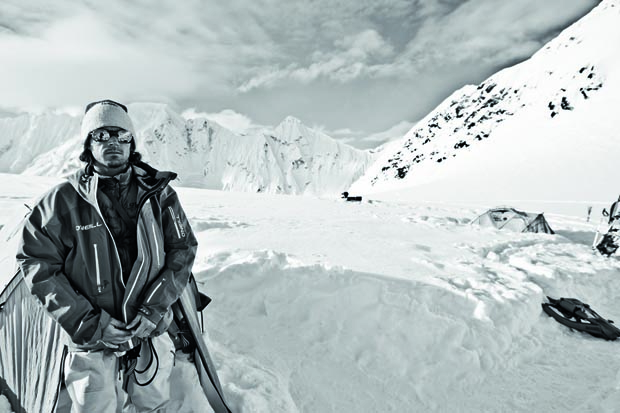
Which model do you generally ride then?
I’m in a conundrum right now ‘cos I show up to the mountain and I wanna ride ‘em all! (laughs) But the Hovercraft is a board I’ve been wanting to make for a long time – it’s a 178 squished into a 156. I got that board and I tested it in Europe but it wasn’t until I got home that we had a nine-foot storm, and I was rewarded with eight days of bottomless Hovercraft testing.
Most powder boards have a pointy nose but the Hovercraft is really blunt. What’s the idea there?
Yeah, at first look you go, ‘Oh, it’s like a Burton Fish.’ But it’s very different. There’s so much plowing that goes on in powder right in here (points to the wide points) that by adding volume in this part you get the volume of a much longer nose. If you watch your nose when you’re riding powder, all your drag is on your corners; very rarely is it over the tip of your board. I feel like 70 percent of falls start from the nose, and that’s why we spent so much attention on our transition points. And then you get into this tail, and you see how thick and low profile it is? If the tail was scooped up more, you wouldn’t use the back corner. So this is a short tail but you use every centimeter of it. It’s very powerful.
Did you approach Nidecker or did Nidecker approach you?
I was looking at a variety of different manufacturers. I was actually very tentative in starting Jones Snowboards – it wasn’t something I was gonna do no matter what. I had two other [sponsorship] deals that I was bringing along at the same time as this and it wasn’t until all the stars aligned – one of them being Nidecker – that I went ahead. We kept going back and forth with Henry Nidecker and I felt that passion for building snowboards that I have in riding them. I kept thinking: ‘Man, I really wanna work with this guy.’ So in the end we had these three deals on the table and I couldn’t walk away from doing my own thing.
Good snow can be found consistently, right away from the chairlift, if you’re willing to put a little effort towards it.
What were the other two deals?
I can’t tell you! One was a bigger company and one was a very small company.
It’s pretty obvious when you look around a tradeshow like this that freestyle is where it’s at with the market. A lot of casual riders must look at big mountain riding in Alaska and think, ‘Yes that’s the purest expression of snowboarding, but it looks really scary and I don’t think I’ll ever do that.’ How do we get more people out of the park and riding powder – and riding it safely?
Well, first and foremost, you really need to respect the mountains. There’s so much information on how to go into the backcountry. Anywhere within 500 miles of where you might find an avalanche, there’s an avalanche course. You need to take a day and take that course; you need to get online and read what’s out there. With the Deeper movie, we’ve spent a lot of time [promoting the] the safety side of it; we make videos that are online for free; we blog about it; there’s avalanche forecast sites out there and great guides… so for people with just a little bit of energy, it’s all sitting there. People will hold your hand and take you into the backcountry. Very quickly you get into this mountain community and you start surrounding yourself with people who have more experience. But ultimately it’s not rocket science: if you read the report and see that’s it’s high avy danger, you go to the resort! You don’t have to dedicate your life to it or go to college, just pay a little attention to the safety side.
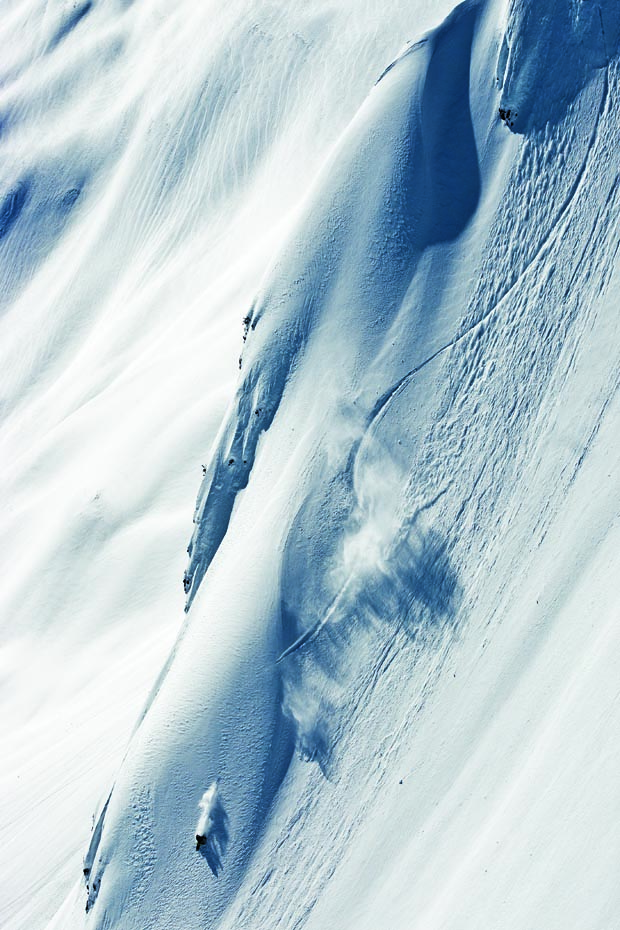
And as soon as you’ve had one good powder line, I guess that opens a lot of people’s eyes?
Well, a lot of why I’m doing Deeper is it’s all foot-accessed stuff in these [freeride] meccas, and my goal is to show that world class freeriding can be done on foot. You don’t need helis, you don’t need snowmobiles – it’s not this big budget deal. And to show that good snow can be found consistently, right away from the chairlift, if you’re willing to put a little effort towards it.
So was this film also something you’d thought of doing for a long time?
Yes. I’ve done 45 movies and this movie I’m doing for myself. I got to a point where it was so clear to me where the passion lay – the part of snowboarding I was getting the biggest highs from – and that was when I hiked what I rode. Over the last five years the backcountry in these meccas has got more and more populated. We’re battling for lines, it’s heli wars, and the solitude as well as the exploration has gone away. But I’ve known that there’s this vast unridden realm that’s outside the heli boundaries, the sled boundaries, and outside of a short hike from the lift. Really, if you look at the map of where we were riding in the past, it was about five percent of the range. Now – ‘cos I’m not afraid to spend the night, I’m not afraid to walk for long periods of time – it’s opened me up to 95 percent more lines, and it’s an incredible feeling.
Do you think you’ll ever go back to filming with helis?
What I’m doing now will definitely continue to be a large part of my focus, but I won’t say that I’ll never get in a helicopter again. If there’s special circumstances that motivate me then I might – like Travis Rice for instance is doing another movie, and I’m considering doing a two-week trip with him which will probably involve helis. I’m not gonna sit here and say that I’ll never get in one again or that helis are lame. They have their place; it’s just with the economy and the environment and everything, and the chapter I’m at in my snowboarding right now, I’m getting a much richer experience by hiking when I ride.
Is the length of time it takes to hike the reason why this is a two year project?
My goal is to have the best snowboarding I’ve ever done be in this movie, without helis and snowmobiles. But by taking away those things, I’ve taken away the best tool in the world to go film big mountain snowboarding! So we need every bit of two years. And it’s not like we’re spending twice as much time [accessing lines]; we’re spending five times as long. We can go four days in the mountains just to get to one line sometimes, and then the weather comes in. In the past I’d wait, see the weather window, hop on a snowmobile, and on the right day I’d have seven shots. With a helicopter too, when the stars align, that’s a seven shot day. In the right conditions – with a heli – I could film a damned good video part in two weeks.
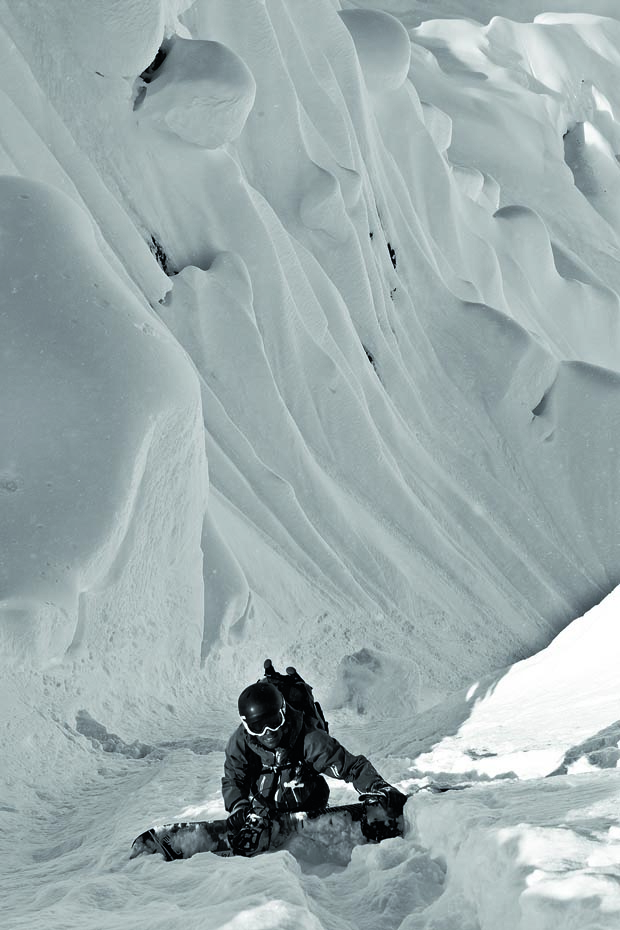
My goal is to show that world class freeriding can be done on foot. You don’t need helis, you don’t need snowmobiles – it’s not this big budget deal.
And I guess a two-year thing gives you a chance to get some other people on board?
Yeah, we definitely have a good cast of riders.
How did you get Travis Rice to sign up?
Travis was the first guy to commit to it. He’s like, “Camping? Alaska? Splitboards? I’m in.” I was like, “OK, well I’ll believe it when I see it,” but sure enough leading up to the trip I’d get a call every two weeks, like [puts on an excited voice] “So what about this? What about this? What about this?” Apparently he spent so much time researching it at his house, he had this huge dome tent set up and he was cooking on his gas stove. He was so into it! He was originally supposed to just be with us for 10 days, he changed his trip three times and ended up spending 25 days with us – camped on a glacier. He had, quote unquote, “the trip of a lifetime.”
Do you think he’s the future of freeriding?
I think he’s part of the future of freeriding for sure. Travis Rice is definitely leading snowboarding right now. He’s kinda the guy.
Every time someone tries to predict how snowboarding will progress, they say ‘freestyle in the backcountry’. Is that still the case? Or is it a slightly elusive quest?
Yeah. The thing about freestyle in the backcountry is: for one, it’s gonna continue to evolve. And who knows – Travis Rice is a guy for whom anything is possible; his level is so high that who knows what’s in his head and where he’s gonna take snowboarding in the next five or ten years? But for two, what you’ve seen is a lot of guys who are bringing freestyle into the mountains, but they’re actually riding these very short lines over and over and over again, to get their tricks. It’s good to have that familiarity with terrain – and that’s where you’re gonna see true performance progression – but freeriding is also about exploration, and for me I always wanna be riding new stuff. So I think you’ll find a facet of both; but with Travis Rice, he’s got the capacity to hit these smaller lines and do tech tricks, and then over time go hit some real, legit, big mountain lines.
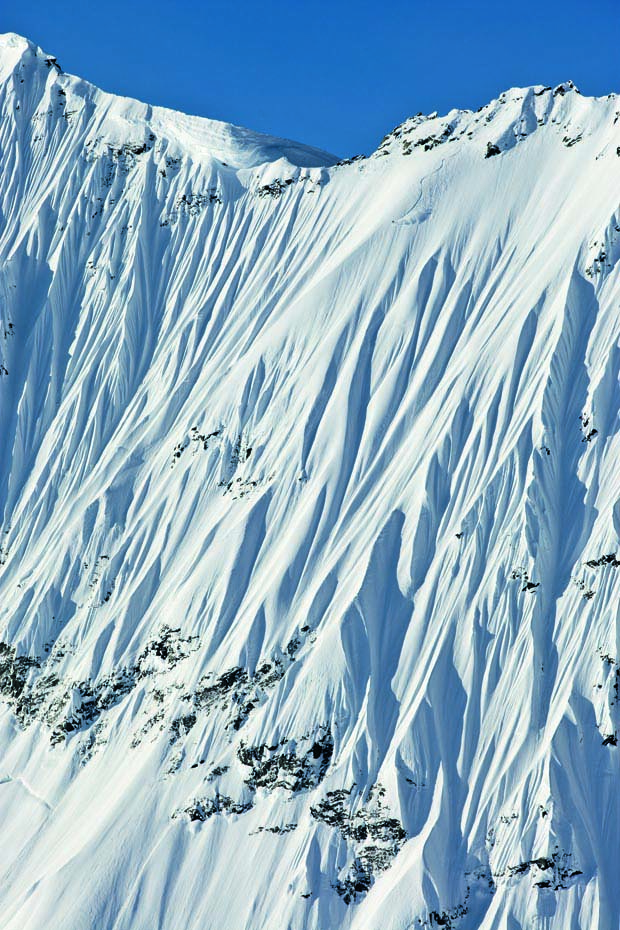
Jake Blauvelt’s in this film too right?
Yeah. He’s another guy who I emailed and ten minutes later it was: “I’m in!” (laughs)
He’s a pretty amazing rider eh?
Oh yeah. It would be a dream come true to have him on the team – he embodies Jones. We grew up in the same town in Vermont actually, although I didn’t know him back then. But you’ll learn – Kevin Pearce, Kyle Clancy, Jake Blauvelt, Ross Powers – Vermont produces some really down to earth, awesome people.
How’s Johan Olofsson’s riding these days?
Johan… (smiles) I mean… it’s great. (laughs). I just love watching Johan snowboard. Just on simple lines, he has a style that’s so unique. He’s a wild animal.
Cos he dropped off the map for a while didn’t he?
Yeah, and I’ve been trying to bring him back onto the map for a while now. But Johan… he’s a free spirit. And that’s what I love about him.
There’s so much information on how to go into the backcountry. For people with just a little bit of energy, it’s all sitting there.
Is he still riding the (binding-less) noboard?
Last we heard he was freaking his agent out by telling him he was never gonna ride bindings again!
Y’know, he came to Alaska and he was so excited he was on a splitboard trip at the time, so all he wanted to do was splitboard. But noboards and splitboards are Johan’s world – at least as of last year. It changes by the minute.
What’s your take on noboarding? Have you tried it?
Yes I have, and I think it’s awesome.
Do you surf?
Yes I do. But I think all these extensions of snowboarding are really cool for the sport.
Are we gonna see a Jones noboard then?
Eventually I hope so, yeah. I just met with the Noboard guys, I’m a huge fan of what those guys are doing.
How did you first hook up with [British photographer] Dan Milner?
Dan is… lemme see… Well, Dan is the ‘Brit Wit’. We like Dan. I met him in Jackson Hole and he was one of the few photographers who could keep up. The cool thing about Dan is he’s not afraid to suffer either. And sometimes when we’ve been filming ‘Deeper’ we’ve thought we should change the name to ‘Suffer’! (laughs) But Dan has an awesome attitude. I spent one day with him and it was clear he gets around the mountains really good, he never complains and he’s got a really good sense of humour. So I was like, ‘You’re invited again!’
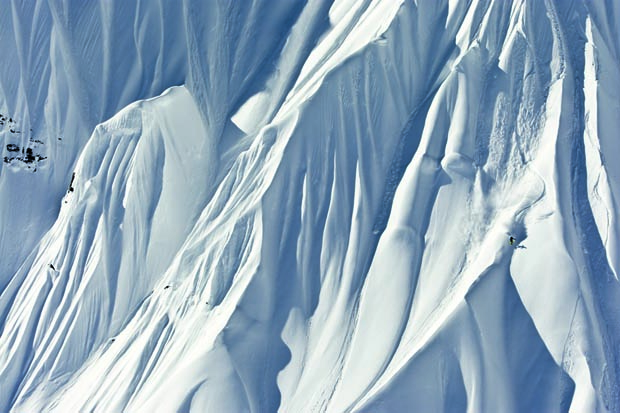
How was Antarctica? [Jones filmed there with Xavier De Le Rue for the forthcoming Relentless movie, Lives of the Artists 2. Some of the footage will also appear in Deeper]
Antarctica was out of this world. Nature on acid! (laughs) It’s just the most phenomenal, steep, sick terrain – right off the water, surrounded by wildlife everywhere. You could be like, ‘this is the most beautiful view of my life’ and then turn around and think: ‘it’s actually better behind me!’
Are they proper high mountains then?
Well, they come right outta sea level. So we found ourselves 500 feet above the sea on these critical, Chamonix-like faces. Immediately we’re fully roped up and right into the mix. But they also have some huge mountains – they have a 9000-foot mountain there that’s straight outta the water. I was looking at the shoulder of it from the zodiac [boat] thinking ‘that looks good’ but the guide driving the zodiac was like, ‘that mountain’s 9000 feet’. I was off by double! I’ve never been that far off in scale. And steepness too – we’d hit something that looked like a nice warm up run, and next thing you know we’re using two ice axes, and it’s 55 degrees. And we’d have stuff that we’d get to the top of and realise: ‘This is actually unrideable’. It’s rare for me to get it so wrong. What I’ve learned over the years is that a smooth face holding snow is – at maximum – a 65 degree slope; but we had situations in Antarctica where we’d see a smooth slope, totally holding snow – like a long chute – we’d get to the top of it and it was basically a vertical cliff. 80 degrees, 85 degrees. It’s a phenomenon. It adds a whole other plane to anywhere I’ve ever seen for steeps.
It’s expensive to get to Antarctica right? I guess you couldn’t have done that without Relentless’s cash?
Yeah. Well to put it in perspective, the budget for the whole Deeper movie is similar to that one trip. Or looking at it another way, Deeper is less that That’s It That’s All’s Alaskan budget. We’re eating Clif Bars and living in tents and lovin’ it. TITA is one of the best movies I’ve been in, but this is at the other end of the spectrum. It’s down and dirty. If TITA was shot from outer space, this was shot from the ridge with the rider. My first three months filming for Deeper cost me 300 dollars. I get sick of people saying: ‘Well I don’t have travel budget, and the snow’s no good, and I need a snowmobile’ and so on. You don’t. And we’re proving that with Deeper. Our month in Alaska – which was a full first class trip with food and everything – was 2000 dollars. It could’ve been half that if we’d had any budget concerns.
Antarctica was out of this world. Nature on acid! It adds a whole other plane to anywhere I’ve ever seen for steeps.
I gotta ask – how did you get the scar on your face?
From a fall in BC about five years ago, filming with Standard. I fell going down a run really fast and caught an ice chunk to the cheek. It’s my big mountain tattoo! My parents and wife wanted me to get it cleaned up – I could basically get it taken off – but I was like, ‘Well, I’m not outta the weeds yet! If you want it off when I’m done doing what I’m doing, OK, but I could have another one before then.’
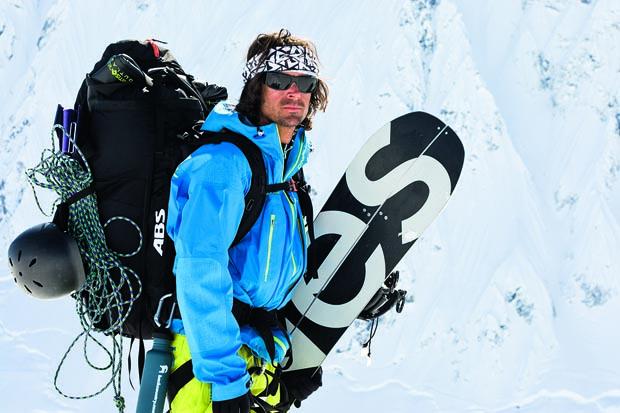
What’s the best line you’ve ever done?
The thing for me is – and this is a Craig Kelly quote – I choose to emulate the snowboarder having the most fun. It’s taken a while for me to understand what that really means, but what I’ve realised is that it’s all about what gets you bouncing off the walls at the end of the day. If that’s hitting a rail then that’s fine; if it’s getting dropped off in a heli that’s fine… But to answer the question, there’s been a few lines where I’ve got to the bottom and I’ve been shaking, I’ve been dry heaving, and I’ve had tears in my eyes. I had two of those last year, I had one of those this year. I’ve probably had five in my life.
What was the last one?
The last one was really amazing, ‘cos it was in my home resort. So to get that experience at a mountain I’ve ridden more than any other mountain in the world just goes to show how cool the sport of snowboarding is. It takes you to another level. We call that the ‘white moment’ by the way: when you’ve worked your whole life to get to this moment where – physically and mentally – everything comes together in unison. You may never achieve it again, but when you do, that’s the ‘white moment’.
It must be even more special knowing you’ve hiked your own line?
Exactly. You get this endorphin buzz on the way up – what’s called the runner’s high – and then you get the adrenaline on the way down, and that cocktail of chemicals, man… it leaves you screaming like a little kid. It’s not uncommon for me to be screaming at the top of my lungs! We put sooo much into these lines that when you finally get one and you ride it right – and you’ve just barely pulled it – you’re high as a kite for days. You’re untouchable. And that’s what led me to this [Deeper project]. I started to realize that I wasn’t getting that from a heli; I’d ride these sick lines and go home at the end of the day but my brain would be tired. Then at the end of the year I’d go out and hike these lines that I wanted to do for myself, and I’d come out the bottom and I’d be so excited; I’d come home and my wife would be like, ‘What are you on?!’ Like I say, those good lines leave you untouchable. If you get a speeding ticket, or charged extra baggage on a plane, or someone steals your shit out your car, you don’t care. You’re on a different plane to the rest of the world.
Wow. It sounds more like surfing. How every wave is different…
Right. Each line is its own story; it’s like a big drama.


